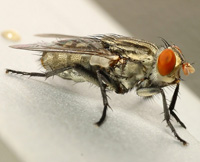Common house fly biology

Common house fly, “Musca domestica”
The common house fly (musca domestica) found in or near buildings and is associated with human activity. This fly species is attracted to suitable breeding conditions, consisting of damp organic matter containing a high level of protein.
Adults are 5-8 mm long, grey with stripes on the thorax. The underside of the abdomen is pale-yellow in colour. Female flies lay up to 750 eggs in batches of around 150 at a time. Maggots are white at first, but become beige as they develop. They go through 3 skin molts and it will only take 5 days, under favourable conditions, to pupate.
Maggots prefer the semi-liquid part for feeding, but migrate to drier parts when they are about to pupate. Common house fly pupae are dark brown to black in colour and are located in the driest part of the food medium. Depending on temperature a fly will emerge from the puparium some days later. It works its way out from the food media by using a balloon-like extension on it’s head. Once in the open air it can inflate it’s wings by pumping liquid through veins and finally hardening of ceratin to appear as true house flies.
The common house fly is regarded as one of the most important public health pest, as they carry a wide range of pathogens (i.e. dysentery, typhoid, Cholera) by cross-contamination of filth and food destined for human consumption. In addition vast numbers associated with animal housing and refuse sites can become extremely annoying for both animals and people. House flies can travel several miles and quickly discover new breeding sites associated with human activity.
Methods to control common house flies
The first line of defence against house flies should be to prevent suitable breeding sites by removing protein-rich organic matter. Bins, manure heaps and rubbish tips should be covered by plastic sheets. Drains should be cleaned and windows should be fitted with fly screens with a mesh size of 1.5 mm. Electric fly killers (EFK) are fine for an occasional house fly, but the common house fly is not particular attracted to these. EFK’s are not recommended when a large number of common house flies are presented, associated with favourable breeding conditions (i.e. manure and refuse sites).
A chemical approach to quickly knock down fly numbers is by the introduction of non-residual pyrethroids aerosols via an Ultra Low Volume (ULV) dispenser (ULV).
It is allowed in an agricultural setting to use the chemicals imidacloprid or spinosad as a paint-on formulation (not for domestic purposes).
Maggots in manure heaps can be eradicated by using the insect growth regulators cyromazine or diflubenzuron. These chemicals disrupt the molting process of maggots and prevents flies emerging. However it does not affect adult flies.
